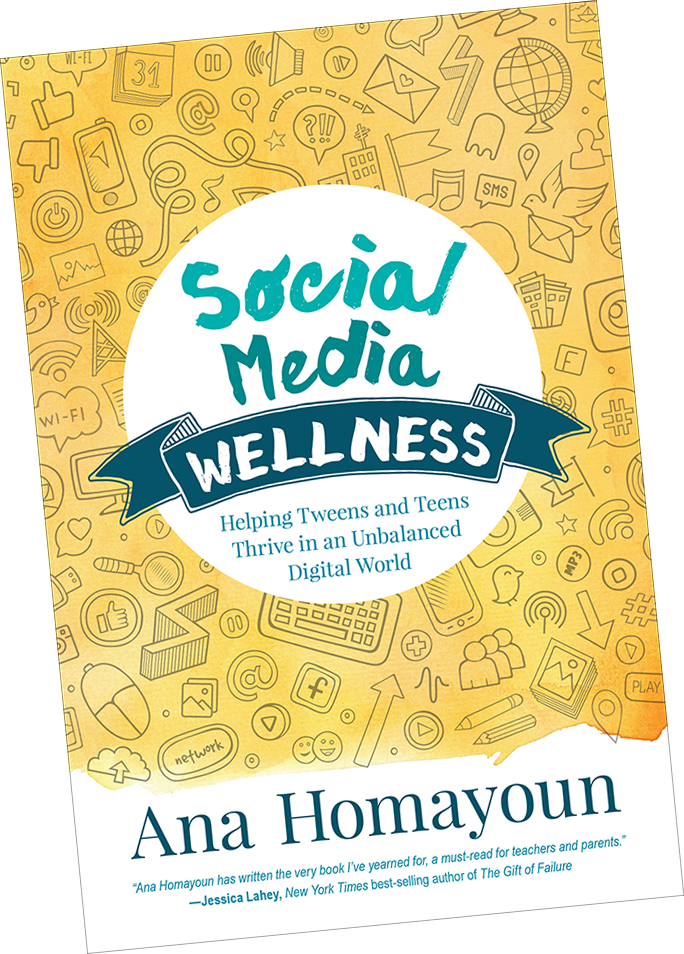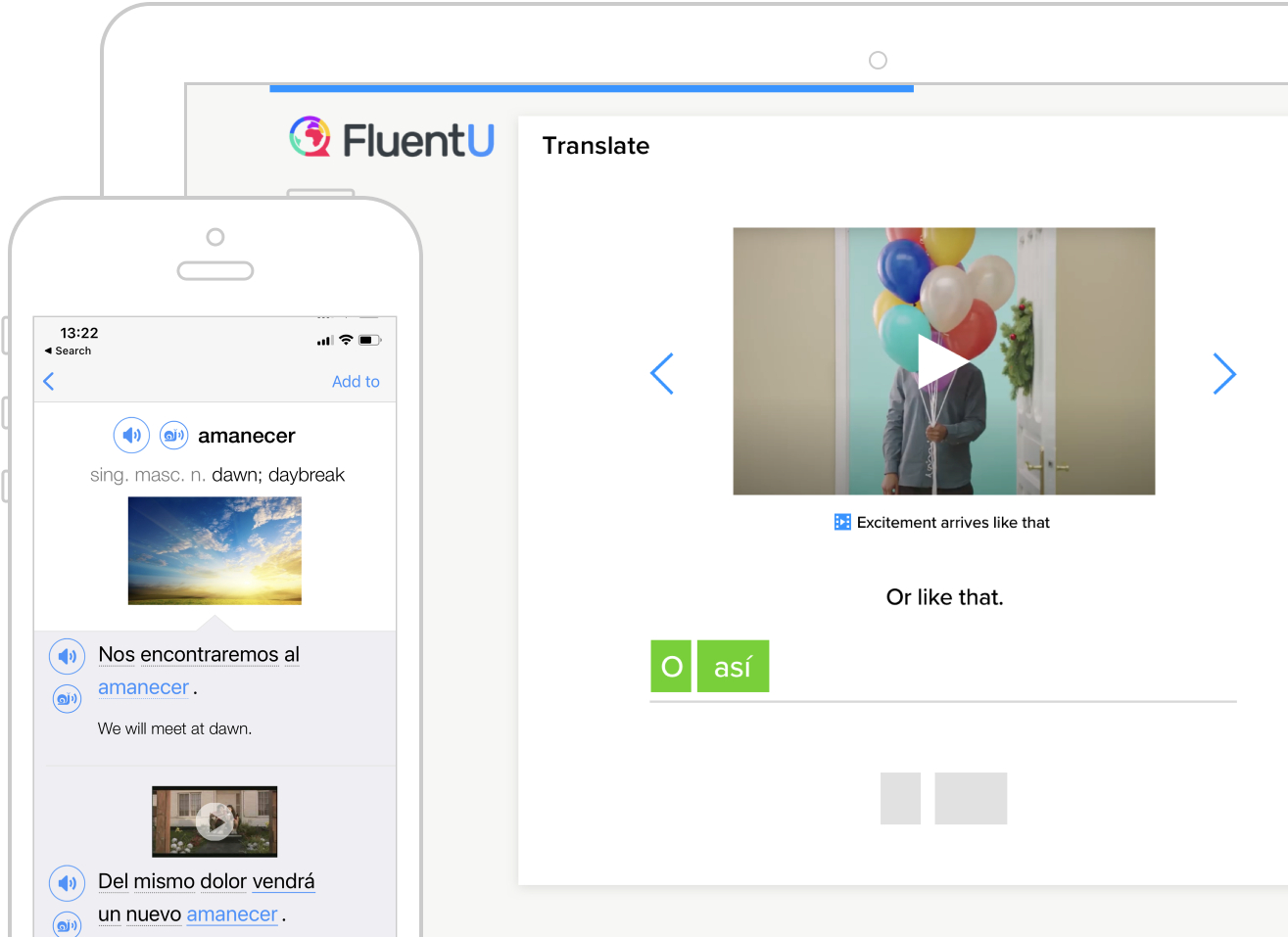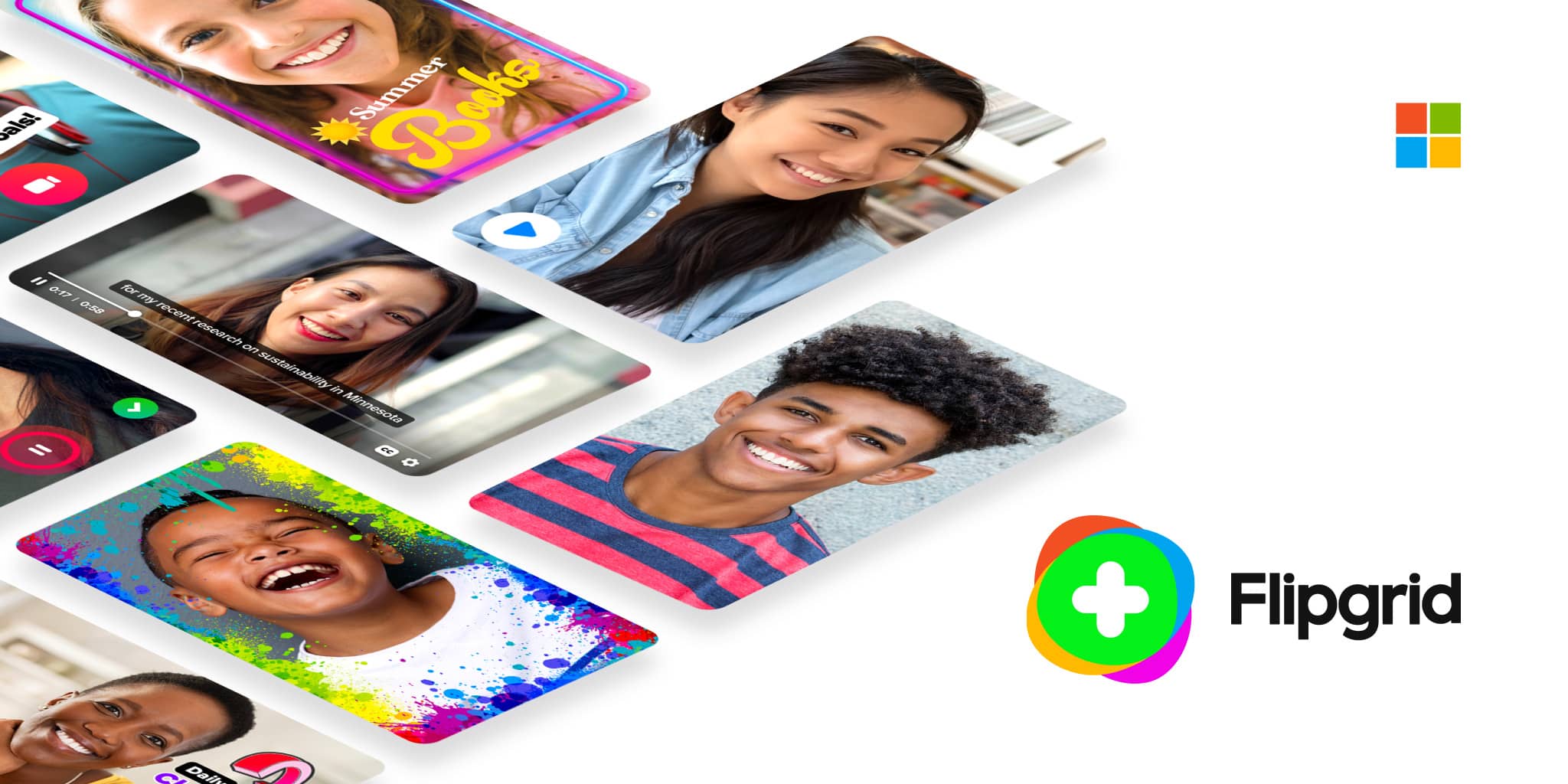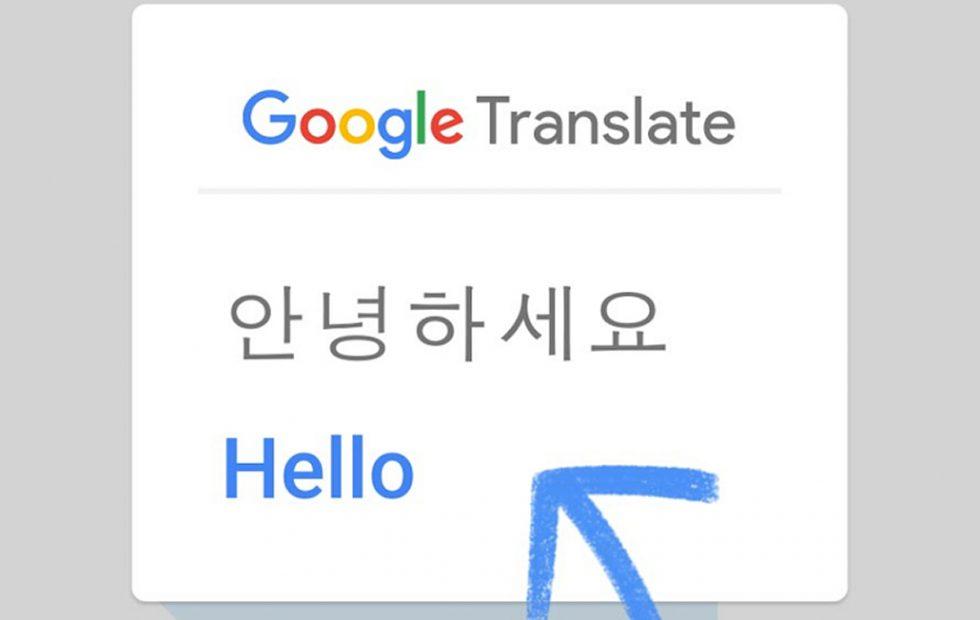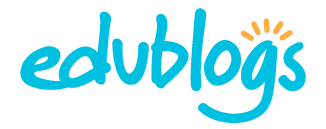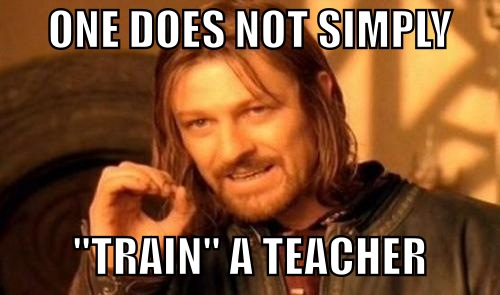As parents, we all want to be able to protect our children from the world and make sure they grow up with confidence, self-awareness, and great interpersonal skills. As a parent, I want to make sure my little girls grow up nurtured and loved, and although a little bit sheltered because realistically I want them to be safe from traumatic and damaging experiences. Some of the most used applications that I discussed with my high school students recently involve the ever-popular, Facebook, Snapchat, and TikTok, all of which involve the opportunity to connect and interact with peers and others.
Facebook:
What is it? Facebook has been around for the longest and acts as an online connection to people, places, and events. There are so many uses for Facebook including sharing posts, photos, websites, and videos. People can create events, tag each other in any of the different mediums shared.
When allowing a child to use social media such as Facebook it is often a good idea to maintain open communication about expectations you have with your student and how they interact with others online. Your student will want to maintain good privacy settings, talk them through setting them up, talk to them about monitoring who and what they are tagged in on Facebook. Future schools and employers look at social media accounts when accepting and hiring. Help them not share personal information that others could potentially use against them.
Snapchat:
What is it? Snapchat is a more creative approach to sharing photos and videos, where you can directly send one of these media and then your connected friend who views it only has a certain amount of time to see the pic or vid. There are filters and voice modifiers to make interacting fun and entertaining, and a way to create a story in one’s profile that shares a day's events, only for twenty-four hours.
Help your student by setting the expectation that they must adhere to family rules and etiquette online. Snapchat can be potentially damaging when pictures and videos are shared from one phone to another. Something that was meant to be private could be shared with others and the world. Parents should talk to their students about the importance of privacy and not adding people to their Snapchat friend list who they do not know.
TikTok:
What is it? Tiktok has been a newer invention and allows users to create mini-videos, about 15 seconds and string four videos together for a maximum of 60 seconds in a story. The videos can be spliced together with friends, have added Augmented Reality features and incorporate music from around the web. Tiktok allows it's users to add friends, curate their videos and liked videos to share with those they connected with.
Parents can help their students by making sure they understand friending random people can be dangerous and potentially expose them to unwanted videos. Students should have good privacy settings so not everyone can see their videos, and make sure they are using the app in an acceptable way that their parents agree on.
Using good common sense to help guide your own student in this world can help keep everyone safe. Young adults are looking for connections and finding them all around the world in the apps that they use. A simple way to keep your teenager safe online is to talk with them and set the tone for them to be able to come to you and speak about any issues.
During an online course, I was tasked with reading Social Media Wellness, by Ana Homayoun. If you would like more information on how to connect with your teenager about social media, I highly recommend this book!
Friday, August 23, 2019
Friday, August 2, 2019
ESL 509 - iTunes U Blog Reflection
Another great investigation for my ESL 509 course led me to find a great iTunes U ESL Course. The Bellmore-Merrick Central High School District in Long Island, New York put together a great set of course materials to review ESL students and some best practices to work with English Learners. The first video really sets the tone and challenges the staff to break the stereotypes of many culturally different students. The course has great videos made by students and also example projects by students that can be used in the classroom.
There are six videos, two images, eight weblinks, and six articles to read and engage anyone using this course. I like the diverse uses of media and the use of writing prompts to help share the learning in this iTunes U Course. There is a lot that can be learned from this course and I think it is great that it was put together by a teacher and her actual class. This format can have a lot of potential for life-long learning from the students about how media can teach others, and how to use the different technologies themselves.
There are six videos, two images, eight weblinks, and six articles to read and engage anyone using this course. I like the diverse uses of media and the use of writing prompts to help share the learning in this iTunes U Course. There is a lot that can be learned from this course and I think it is great that it was put together by a teacher and her actual class. This format can have a lot of potential for life-long learning from the students about how media can teach others, and how to use the different technologies themselves.
Labels:
#edTech,
Digital Media,
Discussion,
EL Learners,
ESL,
ESL509,
iTunes U,
Learning
Saturday, July 13, 2019
ESL Blog #6 - #CSForAllPA
For the 2019-2020 school year, I am planning on teaching the AP Computer Science Principles and AP Computer Science-A courses. The courses are not only a recommendation from the Commonwealth of Pennsylvania, and the Department of Education, but also another step in the direction of equity for students in our diverse population. With computer science coming into its second year at William Penn SHS, I am committed to making sure all students are represented from all backgrounds. That being said, I also have to be very strategic in how I am making these curriculum's available to students in our district.
A pair of professors at Northwestern are also trying to make computer science more inclusive. Sara Hood and Ian Horswill are looking to expand computer science offered to EL students, women and African Americans. They are working to make sure all student have a safe space to practice computer science and realize that failure is just a stepping stone when creating computer programming. The two are also making sure that students in the CS111 introductory course are coding for a purpose, to make something personal and worthwhile. Giving students personal connections to a course make it more meaningful, and something that I can do with my CS students and the projects they are going to be creating.
CS Programs for EL Students
At the University of Texas in El Paso, Tech-E classes, seminars, and summer programs have been created to increase migrant student exploration in computer science. The article I found in my Google Alerts talked about the start of this program in 2015, where it was just a small summer week-long camp, and that it has grown to full-semester courses offered yearly to undergraduates at UTEP. The program is very strategic in offering experiences to students who are in transient worker families and exposes them to computer science and engineering. This program is something that I think could be modeled at the high school level, and be used to get students interested in CS at the elementary and middle school levels. |
| CS Tools that could be used to inspire the next generation. Raspberry Pi, Micro Bits & Video Games! |
A pair of professors at Northwestern are also trying to make computer science more inclusive. Sara Hood and Ian Horswill are looking to expand computer science offered to EL students, women and African Americans. They are working to make sure all student have a safe space to practice computer science and realize that failure is just a stepping stone when creating computer programming. The two are also making sure that students in the CS111 introductory course are coding for a purpose, to make something personal and worthwhile. Giving students personal connections to a course make it more meaningful, and something that I can do with my CS students and the projects they are going to be creating.
The Push for CS in PA
Some very alarming statistics came out of Pennsylvania in the 2017-2018 data for students. Out of 4,010 students that took the AP CS exams, only 309 were from minorities including EL Students. Many students do not take the opportunity to try CS and luckily Governor Tom Wolf has already spent $40 Million on computer science grants for students and apprenticeships. All of these initiatives are starting to be pushed in PA for the 2019-2020 school year, and I feel so glad to be a part of the Computer Science For All drive. I am more proud that I began the program at our school a year before the state push. Now I need to challenge more of our EL students to try Computer Science. |
| PA CS Statistics from the #CSForAllPA Summit |
Saturday, July 6, 2019
Blog #5 ESL 509 - New EdTech
After a great 4th of July Week and some much-needed downtime from grad work, I am back at it!
This week my Google Alerts brought me an interesting article from Proactive Investors, Lingo Media Corp is building a new English Language Learning tool. They are a print-based publisher from China, looking to expand how they teach EL students. The article cites in the world today there are 1.6 Billion people learning English as a Second a Language right now. The media literacy giant is trying to break into a new market with its program that will be unique. Harmantas, has some inside details about Lingo Media Corp’s program, stating “A major differentiating feature of the product is Lingo’s speech recognition technology that allows users to analyze pronunciation and simulate real-life conversation scenarios. Users can record and compare themselves with native speakers to match their pronunciation.”
With technologies based on assessing and giving realtime feedback on an L2 student's English speaking skills, students will increase their English acquisition. Technology is on a rise and new ways of educating our students are making everyday tasks more authentic and meaningful for EL students. Courseware introduced by established companies looking to break through to a new way of learning should be highly looked at by educators. Some technologies can help enhance a classroom and even create an easier job for the teacher who is looking to add some mechanics where work can be easily replicated by a machine.
I really enjoy looking for new technologies for use in any classroom. EdTech is a passion of mine and I think a wide variety of technologies can be used to assist in all student learning. Personalizing the learning allows student choice, gives the student a voice and empowers their learning.
This week my Google Alerts brought me an interesting article from Proactive Investors, Lingo Media Corp is building a new English Language Learning tool. They are a print-based publisher from China, looking to expand how they teach EL students. The article cites in the world today there are 1.6 Billion people learning English as a Second a Language right now. The media literacy giant is trying to break into a new market with its program that will be unique. Harmantas, has some inside details about Lingo Media Corp’s program, stating “A major differentiating feature of the product is Lingo’s speech recognition technology that allows users to analyze pronunciation and simulate real-life conversation scenarios. Users can record and compare themselves with native speakers to match their pronunciation.”
With technologies based on assessing and giving realtime feedback on an L2 student's English speaking skills, students will increase their English acquisition. Technology is on a rise and new ways of educating our students are making everyday tasks more authentic and meaningful for EL students. Courseware introduced by established companies looking to break through to a new way of learning should be highly looked at by educators. Some technologies can help enhance a classroom and even create an easier job for the teacher who is looking to add some mechanics where work can be easily replicated by a machine.
I really enjoy looking for new technologies for use in any classroom. EdTech is a passion of mine and I think a wide variety of technologies can be used to assist in all student learning. Personalizing the learning allows student choice, gives the student a voice and empowers their learning.
Labels:
#edTech,
Education,
Educational Technology,
EL Learners,
ESL509
Saturday, June 29, 2019
Blog #4 ESL 509 - Learning English through Gaming
This past week I had the pleasure to attend the PaTTAN conference, #CSForAllPA. Throughout the two days of keynotes and workshops, I attended some on building diversity in the computer science classroom. I recently started teaching AP Computer Science Principles this past year and had a few students who were not native English speakers. One such student came from Puerto Rico, and although he had an excellent education including English, speaking the language was not a fully acquired skill. At the beginning of the year even with his limited English, he and I did bond over our shared interest in computers and video games. This got me thinking about the wide range of "gamers" that are in our world. During the workshops, one that I attended was called, "Supporting Diversity, Equity, and Inclusion through Esports." The presenter had some interesting data and a great anecdote that described one English Learner's journey to learning English by becoming engaged in Esports at his high school. He developed a sense of belonging and had a personal reason for learning English when he became a member of their team, playing video games.
Some downfalls to gaming would be that not all games are designed to provide the basics of grammar or vocabulary, and the structure is not progressive. Meaning, the grammar, and vocabulary are not taught in a way that would build upon itself, and would not be used to help students decipher the building blocks of the sentence and decipher a verb or noun in the context. This is where the teacher would have to step, and scaffold to help English Language Learners with some mini-lessons on the vocabulary, or take a break and help students break down a sentence to identify its structure. Then return to the game for more fun and learning.
Video Game Club
For the past 12 years of advising students participating in William Penn's Video Game Club, that I and a few other teachers have run, I have bonded with more students who had this common interest with me and have met a lot of great students who I would not have had in class. One young man, LaQuinn Thompson, has taken this passion and is helping it drive him to create an esports team within York City itself, with his BEAST Initiative Push. He describes video games as the way he and his family bonded when he was younger and hopes to help other young people bond with gaming. The Esports phenomenon has been growing very steady, and the US has a lot of catching up to do with the rest of the world in this venue, but our very own Harrisburg University team, The Storm, has brought some regional publicity. They won the Collegiate Esports Championship in Overwatch this past spring on ESPN.
 |
| William Penn Video Game Club |
From the Esports workshop I attended, I hope to also bring more of a competitive nature to our weekly Video Game Club meetings, and help establish an Esports team to compete and bond students. The North American Scholastic Esports Federation, helps bring teens and curriculum to High Schools with esports. There are designated roles and beyond the gaming challenges that can bring multiple youths together to create a mindset of community and establish a guide of career paths for their future. My hope is that we diversify and have some English Language Learners who want to join and enhance their educational career at William Penn through Esports.
Video Games for the English Language
In a recent article on, The Conversation, the question was asked, "Can You Learn a Language Playing Video Games?", and the author looked at several Massive Multiplayer Online (MMO) video games and described how players, both young and old, had to communicate in real-time with little time to be self-conscious of how the language was spoken, meaning the player was more likely to just communicate freely and not worry if they were muddling their language. This freedom is likely to build student self-esteem and the use of another language. The high levels of extrinsic motivation to level up a character or find rare equipment for the character, make a player strive to work well with others to do obtain these in-game rewards.
Another blog, 3 Reasons Playing Video Games Helps You Learn English Faster, described the process similarly and said games helped alleviate stress in learning. They also help develop cognitive skills, linguistic skills and provide in-game context to learning. While playing a video game, a developer often makes the player start small and learn all of the mechanics of how a character can move, advance their effectiveness in the game and use their environment. All of the learning is scaffolded to help the player achieve a better in-game character while also learning about their in-game surroundings. The levels grow progressively harder to pass, and in-game puzzles or riddles help challenge the player in learning the environment or obtaining their next goal. Learning happens all through video games and creates a safe place for a student to fail and try again to pass to the next level. English is used in most games, and reading and responding to the passage in context to move to another level is a must for any player and would aid English acquisition by an EL student. Players also can play collaboratively giving them time to practice their speaking and listening skills in English.
Some downfalls to gaming would be that not all games are designed to provide the basics of grammar or vocabulary, and the structure is not progressive. Meaning, the grammar, and vocabulary are not taught in a way that would build upon itself, and would not be used to help students decipher the building blocks of the sentence and decipher a verb or noun in the context. This is where the teacher would have to step, and scaffold to help English Language Learners with some mini-lessons on the vocabulary, or take a break and help students break down a sentence to identify its structure. Then return to the game for more fun and learning.
Through Esports and Video Games, students can learn English, find career paths, develop a sense of community, build trust in learning even at the expense of failure, and all in the safety of a controlled environment. This week has me thinking a lot about how to use these tools with English Language Learners and students of all backgrounds in my school. It is my hope to push the boundaries of my student's education and help them find common ground in the games they enjoy.
Labels:
#APCSP,
#GamingToLearn,
Computer Science,
EL Learners,
ESL509,
eSports,
Video Game Club
Saturday, June 22, 2019
Blog #3 ESL 509 - Statistics for Success
Statistics Growth
In Falmouth, Massachusettes, the school district has seen an increase in students who identify as English learners in the past 10 years. The number grew from 35 students to 105 students, and the district had to find a way to meet those students by adding a full EL program. The program also included adding resources for student's parents as well, partnering with the Cape Cod Literacy Council. This increase and partnership remind me of York City Schools, we have had a gigantic increase in EL students over the past 10 years as well. In the 17-18 school year, we saw 22.6% of our students were identified as English as a Second Language Learners.YCSD should look to find a similar partnership with our local library. Martin Library in downtown York offers a lot of great programs. The local library could help their ever-changing population of city residence with strategic programs. Maybe parents could have English Language support for contacting the district, working on reading the report card, and even finding tools to help with translating, In the 2017 Census, 82% of the foreign-born residents were from Latin America, which may have different cultural expectations on education. Making sure the parents understand the school's expectations and cultural differences in York would also make for a great workshop.
 |
| Martin Library, York, PA |
Around the U.S.
Topeka Kansas has seen a growth in their EL population as well in the past 4 years they rose from 3% to 14% in their EL population. They have added EL teaching positions and paraeducators into their programs. One of their goals is to track EL success after graduation and report out on that success, as their only other means of tracking their student progress is through the Kansas English Language Proficiency Assessment (KELPA). Building from multiple points of data can definitely help define the successes of a program. In York City, we should create a tracking system for the post-secondary success of our EL students, including career and military choices. Not everyone is going into college for post-secondary success and that should be taken into account when rating the students' success after high school.Texas Schools that have a successful EL program encouraging post-secondary schools is another way to look to student success. There were 9 post-secondary schools in a Texas that received a seal of excellence from a non-profit called Excelencia in Education. Adopting this sort of award for high schools that are providing an impressive education for their EL learners might be a great way to increase student and parent buy-in to a program. In York, the York County Hispanic Coalition might be a good program to start the High School seal of excellence for EL programs. Some may think awards for doing what you should be doing are not necessary, but it does build legitimacy in what is being done to teach the students in different ways.
Ideas for the Future
Other educational programs in multiple states have seen a rising population of EL students, and have adapted accordingly. York City has seen this same increase, using a combination of traditional classroom data to post-secondary success can help look at a students' success. Outside partners to support and award those programs can only help in building our students into life-long learners.
Labels:
EL Learners,
ELMath,
ESL509,
Growth,
Hispanic Coalition,
Partnerships,
Statistics,
York
Saturday, June 15, 2019
Blog #2 ESL 509 - EL Students and the Four Skills
During our fifth week of class, we were assigned to read Robert Blake's journal on using, "Technology and the Four Skills." The reading had us investigate technology to help teachers effectively and deliberately teach EL students reading, writing, speaking and listening skills. Each of the four skills is necessary for a class with EL students. Teaching students a vocabulary heavy course like Geometry I have found that I do need to find ways to make students interact with the vocab in different ways.
Speaking and Listening
Out of the four skills, two that lend themselves to one another are speaking and listening. Students in a classroom who need practice speaking and listening to the English language. One article that I found useful in my Google Alerts this week came from Study International and had a list of Top 4 Apps to Help International Students Learn English Effectively, one of the comments from an App developer, FluentU, was really interesting and stated that it, "uses a natural approach that helps you ease into the English language and culture over time." I really liked the perspective and see the app as something that could be useful in our EL department. Students can interact with videos, musical numbers, commercials, news and inspirational talks with subtitles and quizzes that adapt to the student's level of English.
Getting Social in the Classroom listed a lot of great technology apps to use with students and inspired me to think of ways that I could get students to practice using the vocabulary in Geometry in an authentic way. Using Flipgrid, I could have students post vocabulary pre-view videos and then interact with one another by responding after listening to one or two recordings of their peers. Students could then practice using their English skills in the mathematics classroom, and use the technology to listen to others in the classroom. Students would be able to listen to one another, critique their expertise and engage with one another in listening and speaking about content.
Reading and Writing
The Top 4 Apps for learning English Effectively also had an interesting use for Google Translate, using it Live to translate menus, signs or even museum exhibits. This tool would have been useful for the group of students that I had the pleasure to chaperone in Annapolis, Maryland. Students could have used Google Translate to quickly translate the wording on the plaques that were displayed in and around the capitol building. The Google Translate tool can also be used within the mathematics classroom to help translate word problems in the mathematics classroom as well.
Getting Social in the Classroom using social media to help engage students is described as an authentic way to get students to read and write in the classroom. In my first blog, I talked about how I wanted to use Edublogs as a tool for student writing. The one app in my reading that piqued my interest was the use of Twitter. I have been using Twitter to connect with educators around the world, and the thought of linking student writing with the use of a specific hashtag. Geometry students could connect to one another across my periods, and Tweet out real-world mathematics connections. The beginning of the school year my classes could have a competition to find the best hashtag for the Geometry class, and I could then curate the Tweets for the classes to read online on my website.
With all of the online digital tools and applications on mobile devices, there are tons of ways to enhance and support the speaking, listening, reading and writing of my EL Students. I am looking forward to using some of these tools in the future.
With all of the online digital tools and applications on mobile devices, there are tons of ways to enhance and support the speaking, listening, reading and writing of my EL Students. I am looking forward to using some of these tools in the future.
Labels:
#DigCit,
#edTech,
Edtech,
Education,
Educational Technology,
ELMath,
ESL509,
Life Long Learner,
Math
Thursday, June 6, 2019
Blog #1 ESL 509 - Blogging with ESL Students
Over the Summer of 2019, I have the opportunity to increase my pedagogy skills by taking several courses. One of the courses I am engaged in is utilizing technology in an EL classroom, called Computer Assisted Language Learning, ESL 509 at Wilkes University in Wilkes-Barre Pennsylvania. The course has required our class to start a blog, which luckily I already had this one, and use Google Alerts to keep up to date on ESL Technology for the classroom. Several tags I have added include ESL itself, ESL Blogs, ESL Tech, ESL Math and some other Gaming to Learn Alerts. Although they are limited, I have begun to collect some great resources for my teacher toolbox through the Google Alerts.
Blogging in the EL Classroom:
During my tenure at William Penn Senior High School, I have taught the full gamut of mathematics courses until I finally landed in my passion, Geometry. I teach a heavily vocabulary centered mathematics course, that has a lot of terminologies to describe the pictures and diagrams my students see every day. One such set is the "undefined terms" of points, lines, and planes. Within my classroom, I have utilized journaling on a weekly basis to help students process, use, and analyze the terms in Geometry. I have a journaling page that students write on, and usually, every Monday, Wednesday, and Friday and submit each week for a grade. They are asked to describe a process, define terms in their own words, and solve algebraic problems with geometric shapes. I have been toying with the idea for some time, and I think after some much-needed pushes with my research, I want to utilize Blogs in the coming year for students to accomplish much of these written responses.
After researching all of the resources, using EduBlogs will best help me take my writing assignments to a new level. While looking for information I came across some Tips and Tricks on how to use blogs with EL students. Suggestions included having students utilize Blogs to keep up with the written practice of the English Language, then to make sure students write comments after at least one other person's written responses. Setting up a good framework of expectations with a grading rubric is a must in this endeavor, as students will need to make sure their responses are thoughtful and appropriate for a school setting. Blogs can be utilized as a writing platform to connect all student learning as well as help EL acquisition of the English Language.
While reading some more of my Google Alerts one popped up that was interesting to me, "CSISD Trustees Approve New Math Course for ESL High School Students." While we have been struggling with Algebra Keystones and meeting state proficiency benchmarks, there are very few supports for our EL students. Having an EL Math Course could be a game changer for our district. If we had our students in the right supports we would be able to help students grow even more than in previous years. Some of our students could really benefit from having an EL supported Math class to help with skills and vocabulary that they could encounter in our state exam.
This past school year our Algebra courses were enriched by adding the Math 180 online course and curriculum. Students are challenged daily to make numerical sense out of the problems that they see. Maybe just taking this course, adding an EL co-teacher or aid might be just enough to make an EL math course with number sense and language support.
Look out next week for my next writing involving more of my thoughts on teaching EL students with technology!
After researching all of the resources, using EduBlogs will best help me take my writing assignments to a new level. While looking for information I came across some Tips and Tricks on how to use blogs with EL students. Suggestions included having students utilize Blogs to keep up with the written practice of the English Language, then to make sure students write comments after at least one other person's written responses. Setting up a good framework of expectations with a grading rubric is a must in this endeavor, as students will need to make sure their responses are thoughtful and appropriate for a school setting. Blogs can be utilized as a writing platform to connect all student learning as well as help EL acquisition of the English Language.
EL Math Course
This past school year our Algebra courses were enriched by adding the Math 180 online course and curriculum. Students are challenged daily to make numerical sense out of the problems that they see. Maybe just taking this course, adding an EL co-teacher or aid might be just enough to make an EL math course with number sense and language support.
Look out next week for my next writing involving more of my thoughts on teaching EL students with technology!
Friday, April 26, 2019
Sensei Gibson
During my graduate course on Educational Technology Leadership, a reading was assigned and I was posted a question, "Do you see yourself in one of the professors? If so, which one?"
After reading “A Modern Leadership Fable” from Don Hall, I did a lot of thinking about my own style of leadership, and where I have gone throughout my life to bring me to wanting to become an Educational Technology Leader. Throughout my life, I feel I have always naturally gravitated towards the leadership role of an organization. In high school, I ended up becoming the President of the Chestnut Ridge 4-H Club, President of the Laurel Mountain 4-H Club, President of the Westmoreland County 4-H Board, President of NHS, President of Student Council, Vice President of the AFS Club, etc. I stepped away from leadership roles and did a lot less while as a college student, working a job to help pay for my gas, books and other expenses. Once I moved to York to become a teacher I tried to stay clear of leadership roles as well, only helping out with our local Jaycees’ Chapter as a member, and then something just switched back on. While we were voting on board members, I chaired the committee for membership. I joined our Data Committee at the alternative education school I taught at for a year. Once moving back to the High School, I agreed to help be a Technology Liaison, and troubleshoot minor issues within my building for our IT Department (That has since changed). Then I applied for the Distributed Leadership Committee within my high school, now I want to help drive even more change in my building and district.
As an educator my desk is far from perfect, I reference other great teachers in all of my writings and musings, I also feel like I know my stuff and can be counted as a sage sometimes as well. I feel as though the professor from the Fable I am most like, would have to be the Sensei, in all of my styles education, technology, and leadership. I may not always know the right answer but I can find it, I try to stay humble and appreciate what everyone can bring to the table, and in that aspect from Kurt Lewin’s styles of leadership I feel I would definitely be a Participative Leader, looking to make sure everyone has contributed and give a voice to all participants. I am naturally laid back, a procrastinator who accepts his faults and works hard when called for. My own daughter told me that I work too hard sometimes, even when I sit down to just play and build LEGO sets with her for hours at a time.
After starting this discussion, reflecting on my past, present experience and future aspirations, I feel like I bring a lot to the table as an educator, a leader, and as a human being. My wife has been trying to get me to see that I do some pretty amazing things, but I never feel as though they are truly great. I have a lot of self-doubt as to whether or not I am actually doing a good job. Then, I take a step back and see all of the hard work I do to make sure my students are appreciated, valued and gain insight to the world via my Geometry Curriculum, that I have painstakingly curated over the past 6 years. I was a force for bringing more technology courses back into the high school, and making sure students had access to the AP Computer Science Principles course. I am taking the initiative to pursue a second Master’s to ensure I am leadership material and build my schools’ future. I feel that I am exactly what I need to be, Sensei Gibson.
After reading “A Modern Leadership Fable” from Don Hall, I did a lot of thinking about my own style of leadership, and where I have gone throughout my life to bring me to wanting to become an Educational Technology Leader. Throughout my life, I feel I have always naturally gravitated towards the leadership role of an organization. In high school, I ended up becoming the President of the Chestnut Ridge 4-H Club, President of the Laurel Mountain 4-H Club, President of the Westmoreland County 4-H Board, President of NHS, President of Student Council, Vice President of the AFS Club, etc. I stepped away from leadership roles and did a lot less while as a college student, working a job to help pay for my gas, books and other expenses. Once I moved to York to become a teacher I tried to stay clear of leadership roles as well, only helping out with our local Jaycees’ Chapter as a member, and then something just switched back on. While we were voting on board members, I chaired the committee for membership. I joined our Data Committee at the alternative education school I taught at for a year. Once moving back to the High School, I agreed to help be a Technology Liaison, and troubleshoot minor issues within my building for our IT Department (That has since changed). Then I applied for the Distributed Leadership Committee within my high school, now I want to help drive even more change in my building and district.
As an educator my desk is far from perfect, I reference other great teachers in all of my writings and musings, I also feel like I know my stuff and can be counted as a sage sometimes as well. I feel as though the professor from the Fable I am most like, would have to be the Sensei, in all of my styles education, technology, and leadership. I may not always know the right answer but I can find it, I try to stay humble and appreciate what everyone can bring to the table, and in that aspect from Kurt Lewin’s styles of leadership I feel I would definitely be a Participative Leader, looking to make sure everyone has contributed and give a voice to all participants. I am naturally laid back, a procrastinator who accepts his faults and works hard when called for. My own daughter told me that I work too hard sometimes, even when I sit down to just play and build LEGO sets with her for hours at a time.
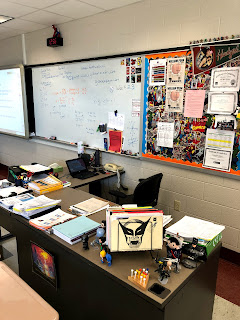 |
| My "cleaned-up" version of my Desk. Much messier now that the end of the year is near. |
After starting this discussion, reflecting on my past, present experience and future aspirations, I feel like I bring a lot to the table as an educator, a leader, and as a human being. My wife has been trying to get me to see that I do some pretty amazing things, but I never feel as though they are truly great. I have a lot of self-doubt as to whether or not I am actually doing a good job. Then, I take a step back and see all of the hard work I do to make sure my students are appreciated, valued and gain insight to the world via my Geometry Curriculum, that I have painstakingly curated over the past 6 years. I was a force for bringing more technology courses back into the high school, and making sure students had access to the AP Computer Science Principles course. I am taking the initiative to pursue a second Master’s to ensure I am leadership material and build my schools’ future. I feel that I am exactly what I need to be, Sensei Gibson.
 |
| My New Badge! |
Labels:
#edTech,
Discussion,
Educational Technology,
Leadership,
Reflection
Sunday, March 17, 2019
Leading Teachers through PD
As a part of our High School's Distributed Leadership (DL) Team, I have been given the opportunity to lead in new capacities for the past four years. I have been trained for three years on the ways of developing teacher skills and school climate. The team and I use the time allocated for our DL team to help bring Professional Learning Communities (PLCs) to life and advocate for using best practices while creating Professional Development (PD) for our staff.
One such day was last January when I lead our Department Meeting time and showcased using QR Codes for staff to get students working and engaged in their classrooms. I modeled one use, by having staff get into groups of 4 and walk around our building scanning QR Codes about the process of using QR Codes in the classroom, while they went around with a group recording sheet. (One person in each group at least had a QR Code Reader.)
It became a huge success and everyone involved said the time used was greatly appreciated and the activity very appropriate for their practices. I revamped the whole project for a recent graduate course paper that I had to make a QR Code activity. I used PowerPoint to give my posters some extra character and even attached all of the QR Code Sites I used in each slide. I then began thinking about what else I could teach them would be the best use of their time, but as we all know one does not professionally develop teachers.
During a second PD, I led, involved looking at Google Sites to create a classroom website. During this planned instruction I gave 10 minutes in demonstrating how to make a Google Site in Google Drive, then showcased my ever-changing work in progress Geometry Website. Teachers were then placed in their departments to play with the Google Site creator and discuss possible uses for a site, what they would want to display or share with students and the world, etc. Attached is my Google Site PD form that was shared out to all staff to work on and share ideas. I designed the Google Doc to be informative, editable, and shareable for the information decided upon by each department.
Through leading teachers with Professional Development, I have become more secure in my knowledge of education and knowing what is good for both students and teachers in my building. I hope to continue on this trend, leading and teaching all new skills that are easily adaptable for any classroom.
Please use and adapt any of the activities I have made for your school too!
One such day was last January when I lead our Department Meeting time and showcased using QR Codes for staff to get students working and engaged in their classrooms. I modeled one use, by having staff get into groups of 4 and walk around our building scanning QR Codes about the process of using QR Codes in the classroom, while they went around with a group recording sheet. (One person in each group at least had a QR Code Reader.)
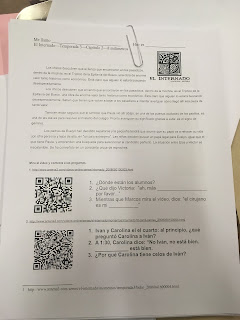 |
| One teacher friend used QR Codes at the end of the year, using the codes to tag a video for students to listen and write in Spanish. |
It became a huge success and everyone involved said the time used was greatly appreciated and the activity very appropriate for their practices. I revamped the whole project for a recent graduate course paper that I had to make a QR Code activity. I used PowerPoint to give my posters some extra character and even attached all of the QR Code Sites I used in each slide. I then began thinking about what else I could teach them would be the best use of their time, but as we all know one does not professionally develop teachers.
QR Code Activity:
During a second PD, I led, involved looking at Google Sites to create a classroom website. During this planned instruction I gave 10 minutes in demonstrating how to make a Google Site in Google Drive, then showcased my ever-changing work in progress Geometry Website. Teachers were then placed in their departments to play with the Google Site creator and discuss possible uses for a site, what they would want to display or share with students and the world, etc. Attached is my Google Site PD form that was shared out to all staff to work on and share ideas. I designed the Google Doc to be informative, editable, and shareable for the information decided upon by each department.
 |
| One of my takeaways from DL Trainings. |
Through leading teachers with Professional Development, I have become more secure in my knowledge of education and knowing what is good for both students and teachers in my building. I hope to continue on this trend, leading and teaching all new skills that are easily adaptable for any classroom.
Please use and adapt any of the activities I have made for your school too!
Labels:
#BearcatPride,
#edTech,
Educational Technology,
GoogleCE,
Life Long Learner,
Modeling,
Professional Development,
QR Codes,
Technology,
Understanding,
WPSHS
Location:
York, PA, USA
Subscribe to:
Posts (Atom)


:max_bytes(150000):strip_icc()/GettyImages-586113582-587422f63df78c17b65ea081.jpg)

